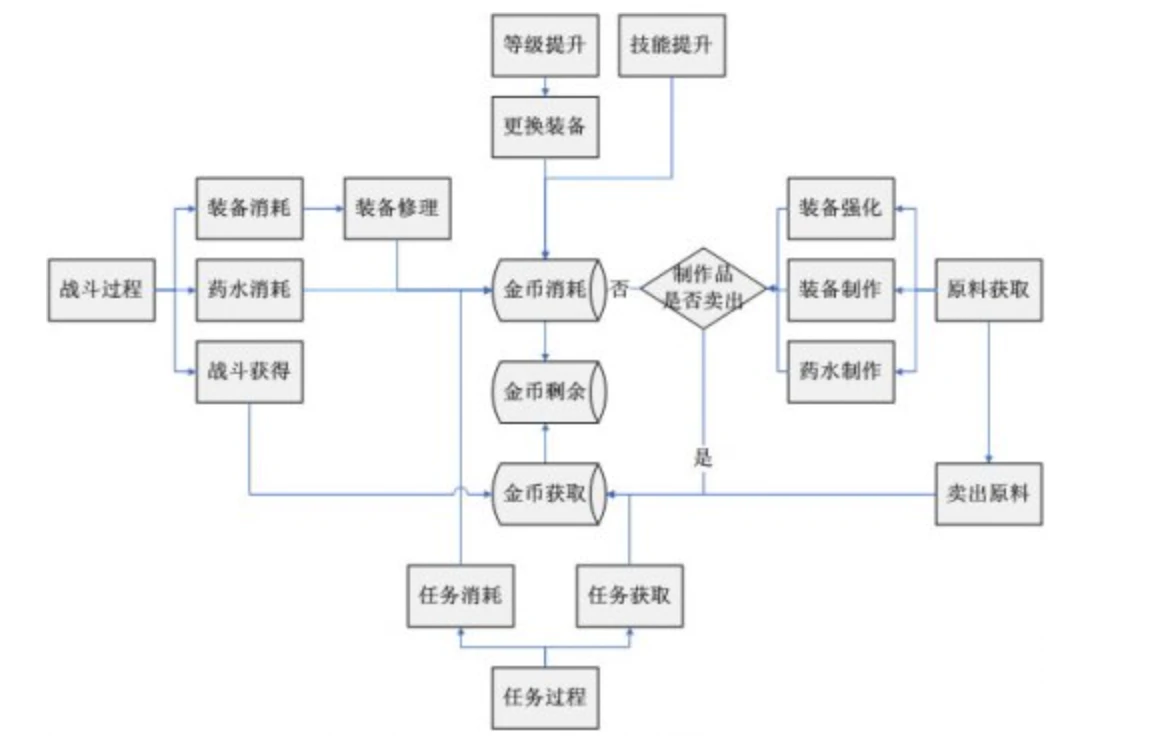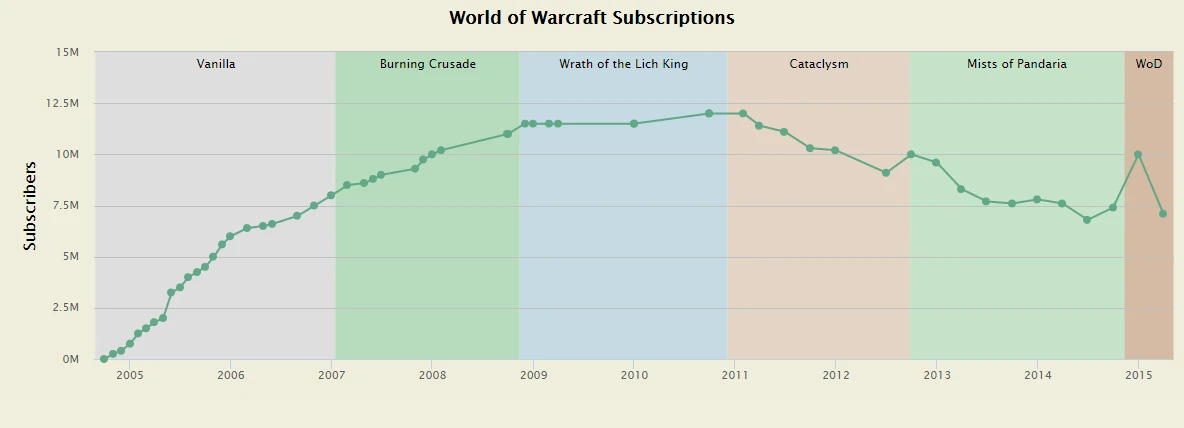From 2D billiards to 4X strategy, traditional RPG games to 3A-level open world, games have never been pure entertainment, but a platform for players to compete around limited resources. For a long time, game currency with circulation value and use value has played a vital role in the games user retention and business cycle.
As a product of the combination of games and cryptocurrencies, the token economy of the Gamefi project has naturally become a part of the game, giving players unprecedented item ownership and trading rights.
secondary title
1. Through Fantasy Westward Journey, how can we correctly understand the economic system of the game?
Speaking of the economic system, we have to mention Fantasy Westward Journey. This old game has been regarded as a classic case for a long time, and it is short of the Harvard case. So, what is the strength of the economic system of Fantasy Westward Journey (hereinafter referred to as Fantasy)?
At the beginning of the game design, Fantasy has determined to establish a virtual society comparable to the real environment for players, from the launch of the courtyard system in Happy Homeland, to the launch of the fertility system in Life is Beautiful, and then to Battle of Destiny The battle to compete for the strongest players in the entire server is all about creating a virtual living environment that is close to reality. The economic system that plays an important role in this is particularly important. Fantasy has achieved great success after drawing on the experience of the Dahua series.

Different from traditional Gamefi, Fantasy with its own virtual society adopts a commodity social economic model, and the means of income are divided into:
Point card income, the official does not sell game assets to players, but distributes production materials to players through time payment;
Money income, such as the handling fee of the treasure house in the game, the purchase of fairy jade, etc.
As the name suggests, point card income means that the more people play, the longer the better, including both ordinary players and studios. This is why Fantasy encourages players to open more and allows studios to exist. More online people have brought NetEase actual point card revenue.
The money income in the game is more like a progressive option for the screened users in the game, for example:
Treasure Pavilion transaction fee. The daily massive Treasure Pavilion handling fee is a considerable income.
All kinds of fairy jade consumption. For example, the secret red Luogeng that automatically replenishes blood, various brocade clothes, etc., are all stimulating players to spend more real money.
It is worth mentioning that, in order to expand the scale of income, the incentive method of the Fantasy team is to expand the overall gross production value by promoting the exchange of goods in the game, thereby increasing income. When maintaining the continuity of income, the first task is to ensure the value preservation of in-game items and characters.
The most external manifestation of value preservation is: due to the existence of point cards, the price of consumables in Fantasy will not be lower than the time cost price of its acquisition, that is, the variable cost in the game must be less than the selling price. But to talk about value preservation, we have to mention the entire macroeconomic system of Fantasy.
Fantasy Westward Journeys economic system is undoubtedly the largest and most complete of all games. From an economic point of view, the simplest entry point is the relationship between supply and demand.
From the perspective of output, Fantasy adopts a method similar to the first-level stock issuance, stipulating that all equipment, props, and babies in the game must be obtained by players through activities, tasks, etc., and cannot be purchased directly. . But what should ordinary players do without so much time? This also gave birth to the emergence of studios. They spend all kinds of game items day in and day out. The bosses who need them only need to buy them in the secondary market. The essence is to exchange money for time. **
It is worth noting that no matter how many hidden processes, complicated tasks and gameplay are set in Fantasy Westward Journey, the resources produced in the game can only be divided into two categories:
Consumables: runestones, pearls, edible medicine, a very small part of fantasy coins, etc.;
Durable Goods: Everything other than the above, including most fantasy coins.
In fact, except for individual consumer goods in the entire system of Dream, almost everything is a durable good covered with a probability coat, and even the vast majority of fantasy coins are also durable goods. Therefore, the entire economic situation of Fantasy is actually dominated by durable goods, with only a very small number of consumer goods in the true sense. Therefore, it also means that in the long run, the price of the durable goods market will continue to decrease: players will open more at zero cost, and studios will only produce without consumption. But Fantasy used a very ingenious method to avoid this from happening - making the summoned beast with the highest turnover rate a pseudo-durable product, that is, let the summoned beast end absorb almost all inflation.
In fact, whether it is housing or automobiles, the broad definition is durable goods. The best equipment in Fantasy is actually equivalent to housing, which is strictly controlled by the team, and products like summoned beasts are like industrial products like cars or mobile phones. Although they have certain durability, they absorb absolutely Most inflation, so more like consumer goods in durable goods.
In the real world, the demand for a certain commodity may be saturated in the short run, but in the long run, the demand for the commodity is infinite because the commodity in the physical world is always consumed over time . Conversely, in-game consumables are worthless without demand, since the value of game resources comes from player interaction and in-game consumption. Currency is scarce and resources are infinite, so if there is not a good relationship between consumption and production in the game world, it will lead to economic collapse. If the relationship between consumption and output is not established in the game world, the game economy will inevitably collapse.

It is for this reason that the value preservation ability of summoned beasts is extremely poor, while the value preservation ability of top-quality equipment is quite excellent. Compared with the existing Gamefi projects, most of them use scarcity to improve the ability to preserve value. Is it true to polish the economic model from the perspective of durable goods?
On the currency side, the Fantasy team with super monopoly power plays the role of the central bank, has many centralized currency control methods, and can control prices freely.
Also benefiting from the fact that Fantasy is a very complete virtual economy, the four most critical economic indicators for macro-control, we can find prototypes in the game:
GDP:The total value of all services and commodities produced by the entire game system within a period of time. Since the value of services is directly reflected in the value of goods, there is no concept of services in Fantasy, and the resulting GDP is the total value of newly produced goods.
PMI:Purchasing Managers Price Index. The role of replacing farmers and miners in the real world in Fantasy is the team itself, so the statistical caliber of PMI is the price at which the system sells raw materials to additional players, 0.6 yuan per unit.
PPI:Producer Price Index. Statistics show that if most players are engaged in production activities, the average hourly output value of each unit is about 3~4 yuan, which is the ex-factory price of the producers product in each unit of PMI.
CPI:Consumer Price Index, which is the price of goods in the game.
In addition, for a virtual economy, there is also the problem of exchange rate. Is it possible to directly treat fantasy currency as a legal currency and renminbi as a foreign exchange? Thus abstracted into: Fantasy adopts a currency system similar to the Bretton Woods system [1], and directly anchors the fantasy currency to RMB for macro-control?
It is obvious that the fantasy coin itself does not fully act as a currency, and the vast majority of fantasy coins act as durable goods, so the fantasy coin itself is more of a commodity. Therefore, the currency system of Dream is more similar to the current Jamaica system[2], and the world of Dream is more similar to small countries such as Zimbabwe and Panama, where the domestic legal currency (MHB) and the US dollar (RMB) are dual-tracked to price commodities , the local currency has basically become the auxiliary currency of the US dollar in the country.
Therefore, in the abstract virtual society, simply by controlling the coefficients and adding content scenes based on the game itself, Fantasy has well balanced the output and consumption of resources in the game, and the operation and circulation of currency, which not only improves the game The degree of controllability also avoids the collapse of the game economy. Then, applying the basic macroeconomic theory, it is not difficult to find that the macroeconomy of Fantasy has fully reached the level of operation and regulation of a country in real life.
In addition, some players of Fantasy will simply pay for the gameplay and social features. This stems from the fact that while Fantasy continuously increases players sense of identity with their social identity, it allows players to invest more time and money in the sunk cost. For example, Fantasy has a powerful social chat system, mentoring system, and marriage system that support its own volume well. Many people get married in reality because of the game.
Of course, the most successful part of Fantasy is that it charges for time. The players time game and currency issuance caliber are all created based on the players value. However, the logic of the unstable economic system of free games is just like real estate bubble games in reality. Neither the game’s sales of props nor the government’s sale of land create real value, and when the demographic dividend of players disappears, the bubble will burst one day.
The online decline of MMO games is faster. For example, World of Warcraft has entered the channel of declining player numbers since the Cataclysm version. Problems such as heterogeneous player types, conflicts of group interests, difficulty in entering the game for newcomers, excessive differences in retained players, and reduced recognition of gameplay are all problems faced by MMO games today.

secondary title
2. In contrast, how should a successful Gamefi consider the elements of its own economic system?
A lesson from the past, a teacher from behind. In traditional game cases, how to retain users is the biggest problem that needs to be overcome from beginning to end. Under the vision of earning while playing and trying to make everyone make money, how to make most people in the game willingly pay like League of Legends or Fortnite players without asking for anything in return? This basic economic system assumption must also be established on blockchain games.
It is obvious that Gamefi must have a group with the sole purpose of making gold. The existence of the studio itself does not cause harm to the economic system, and the design of the game economy will also allow merchants to create value for the system instead of simply extracting value from the system. Under the open economy, players and project parties are a community of interests. In the process of pursuing interests, studios are also trying to produce and sell things that other groups need.
This pursuit of self-interest allows the market to operate effectively, but there should also be a reasonable and healthy ratio. Fantasy increases the friction of commodity exchange through the design of the stall system to increase income. The existence of the studio can greatly improve the efficiency of the bosses and provide better liquidity for the producers. The last point is also a cliché: the studio and the wool party cannot obtain benefits at zero cost. Fantasy reduces the negative impact through time payment, but it also has a certain negative impact on the player experience.
In addition, a social division of labor with a good world view is the prerequisite for the existence of an in-game commodity economy. In Fantasy, the social division of labor is extremely fragmented. Producers, businessmen, and bosses embody their value in different production links, and each consumption is the consumption of multiple means of production. However, most of the existing Gamefi has a single combat power to determine the production method, and it is a better choice to allow stakeholders with different consumption levels to have a way to produce production materials.
The gameplay of Fantasy has a good depth and breadth, and the complexity of the means of production is high. The means of production and commodities belong to different interest groups. The production materials produced by players through tasks and activities will definitely overflow, and there will definitely be gaps. They cannot be self-sufficient, and there will inevitably be a demand for commodity exchange. The Dream team has grasped the core of the relationship between supply and demand, and the control is naturally handy. For Gamefi, how to enrich the output paths and production methods of production materials and encourage players to actively participate in commodity exchanges is an important part of designing game mechanisms and economic models.
In order to pursue the ultimate production efficiency in the competition, the merchant group in Fantasy has continuously subdivided into a multi-level merchant system, and finally shifted the overall production input upwards. And Gamefi should also encourage the competition of merchant groups. Under the specialization of labor, an economy can create more means of production with the same resources and expand the overall production possibility boundary.
In addition, although some traditional game players resist the financialization of games, games and investment can be more organically combined through game mechanics. A long-term stable game economy can weed out speculators, and a game with an adaptive mechanism can also allow investors to benefit from asset liquidity and appreciation. For Gamefi, how to focus on long-term value rather than short-term value, and make the game cake bigger with players is bound to become a required course for the project team.
Finally, too much emphasis is placed on the token model, and even the token model is used as a selling point. Even if the economic model and application scenarios are stronger than Curve, the currency price cannot stand alone in an extreme market environment. Therefore, any attempt to maintain the currency price must be futile. Continuing to infer, any way to attract users with currency prices must also be futile. The inflation of tokens must also be dynamically adjusted according to the players economic behavior to prevent in-game economic activities from offsetting inflation.
However, GameFi is still in its early stages. A large number of players are exploring the boundaries of traditional themes, and a large number of developers are exploring sound game economic mechanisms and game content. Create new paradigms. How to organically combine the economic regulation, actuarial and numerical design capabilities of traditional games with Cryptos incentive model, we will wait and see.
Notes:
[1]: The Bretton Woods system, that is, the international monetary system agreement centered on the US dollar after the Second World War, aims to influence and regulate the exchange of currencies by various countries, the adjustment of the balance of payments, the composition of international reserve assets and other issues .
disclaimer
Reference:
https://www.pocketgamer.biz/feature/77017/top-10-highest-grossing-mobile-games-of-all-time/
https://vgsales.fandom.com/wiki/List_of_highest-grossing_video_games#cite_note-westward_revenue-42
https://www.pcgamer.com/the-5-biggest-pc-games-in-china-that-youll-probably-never-play/
https://mirror.xyz/frostlam.eth/n01yyZtfS3GUQXSSka4re5X_lNOaLQN_Q_bzkJhscXc
https://mirror.xyz/frostlam.eth/VPukp4Q2uQTE2Crep808EfCWEi2xhCRyxECLIzh6hIo
https://racingtime.medium.com/redemption-of-gamefi-the-design-of-in-game-economy-mechanism-39e500afeef3
disclaimer
More information
Copyright Notice
Without the authorization of DODO Research Institute, no one may use without authorization (including but not limited to copy, disseminate, display, mirror, upload, download, reprint, excerpt, etc.) or allow others to use the above intellectual property rights. If the work has been authorized to be used, it shall be used within the scope of authorization, and the source of the author shall be indicated. Otherwise, its legal responsibility will be investigated according to law.
about Us
DODO Research Institute led by the dean Dr.DODO led a group of DODO researchers to dive into the Web 3.0 world, doing reliable and in-depth research, aiming at decoding the encrypted world, outputting clear opinions, and discovering the future value of the encrypted world. DODO is a decentralized trading platform driven by the Proactive Market Maker (PMM) algorithm, which aims to provide efficient on-chain liquidity for Web3 assets, allowing everyone to issue and trade easily.
More information
Official Website: https://dodoex.io/
GitHub: https://github.com/DODOEX
Telegram: t.me/dodoex_official
Discord: https://discord.gg/tyKReUK
Twitter: https://twitter.com/DodoResearch
Notion: https://dodotopia.notion.site/Dr-DODO-is-Researching-6c18bbca8ea0465ab94a61ff5d2d7682
Mirror:https://mirror.xyz/0x70562F91075eea0f87728733b4bbe00F7e779788










